Nature’s palette is adorned with a breathtaking spectrum of feathered wonders, and amongst them, those with striking red chests stand out as vivid symbols of vitality and beauty.
From the vibrant Scarlet Tanager, resplendent in North American canopies, to the urban-dwelling Northern Cardinal, each species weaves its narrative into the intricate tapestry of biodiversity.
This curated collection spans ecosystems and continents, showcasing the adaptability and resilience of these feathered beings.
Beyond mere aesthetics, the red chests of these birds often play a crucial role in courtship displays, territorial signaling, and species recognition.
Let’s join us on a journey through the varied landscapes these avian marvels call home, from the southwestern agility of the Painted Redstart to the melodious tunes of the Rose-breasted Grosbeak.
Birds With Red Chests
Here, we’ll unravel the unique characteristics and behaviors of these 20 birds. We’ll try to profound insights into the interconnectedness of life in the avian realm of these red-plumed ambassadors in sustaining the ecological balance of our planet.
1. Scarlet Tanager
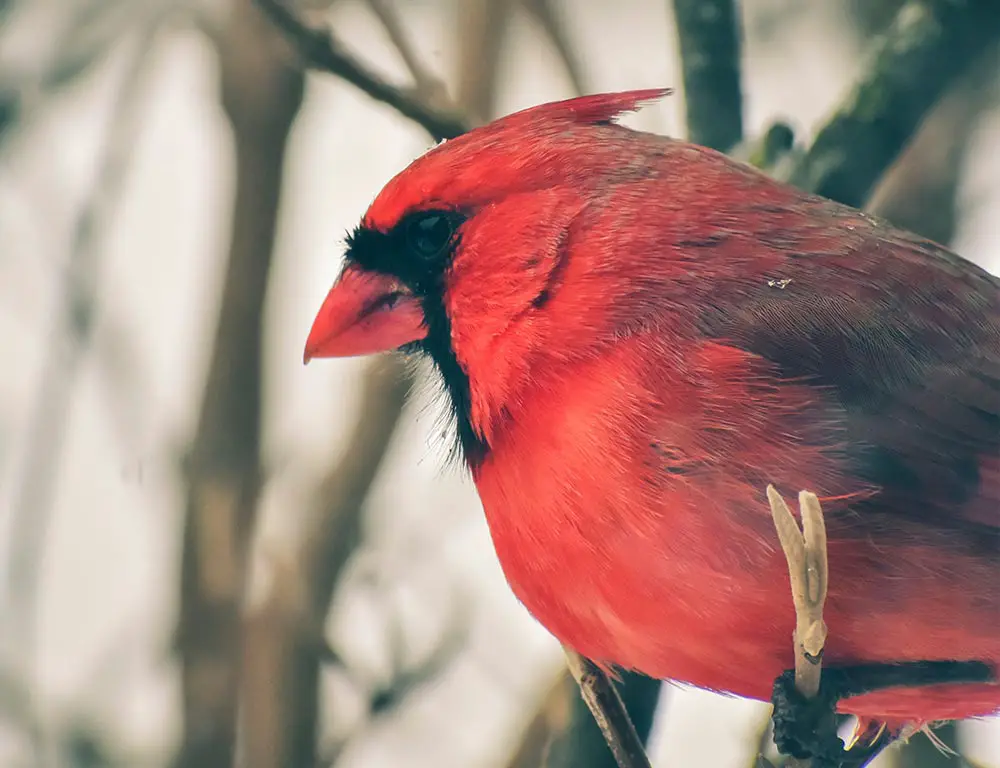
- Scientific Name: Piranga olivacea
- Size: 7.1–7.9 inches (18–20 cm)
- Weight: 0.8–1.4 ounces (23–40 g)
- Wingspan: 9.8–10.6 inches (25–27 cm)
- Population: Not precisely determined
- Life Span: 2 to 5 years
- Status: Least Concern (IUCN)
The Scarlet Tanager is a neotropical migrant, spending summers in North America.
With its vibrant red plumage, it primarily feeds on insects, making it an adept aerial forager. Breeding in deciduous forests, these birds build cup-shaped nests in the canopy.
They are known for their distinctive, melodious songs. During migration, they navigate through Central America to reach their wintering grounds in South America, showcasing remarkable endurance and navigation skills.
2. Northern Cardinal
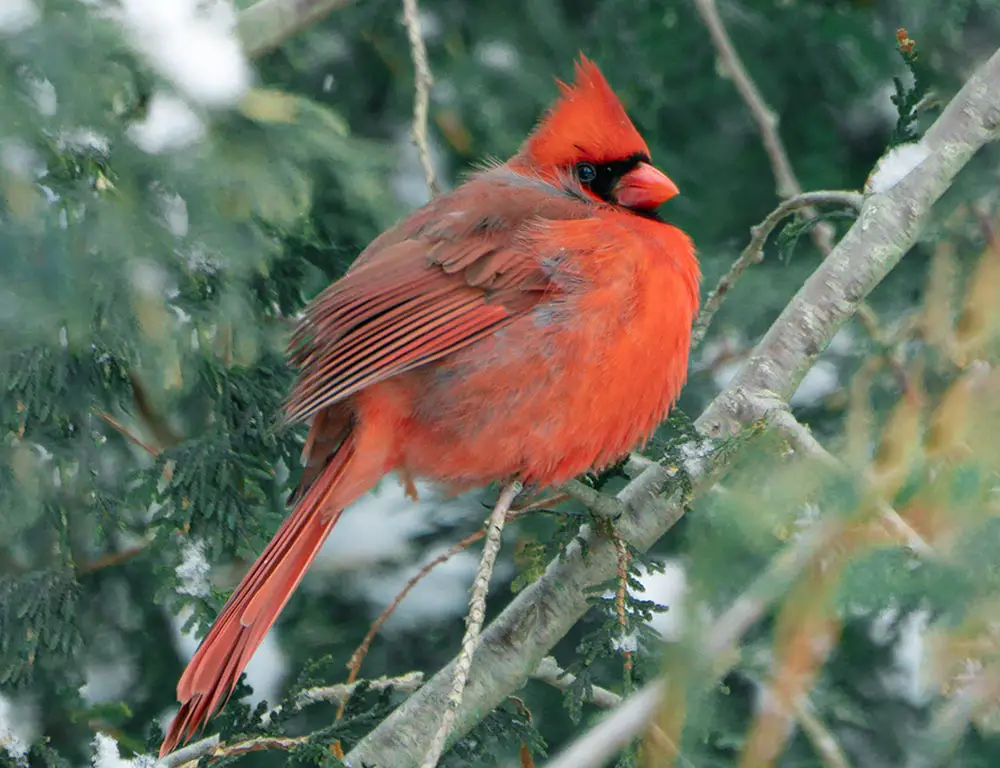
- Scientific Name: Cardinalis cardinalis
- Size: 8.3–9.1 inches (21–23 cm)
- Weight: 1.5–1.7 ounces (42–48 g)
- Wingspan: 9.8–12.2 inches (25–31 cm)
- Population: Abundant and widespread
- Life Span: 3 years on average
- Status: Least Concern (IUCN)
This iconic bird is a year-round resident in North America. With a preference for shrubby habitats, the Northern Cardinal is adaptable to various environments, including gardens and urban areas.
Their diet consists of seeds, fruits, and insects. Males are known for their vibrant red plumage, while females exhibit a more subtle brownish color.
Cardinals are monogamous and defend their territories vigorously, often communicating through a series of loud, distinctive calls.
3. Painted Redstart
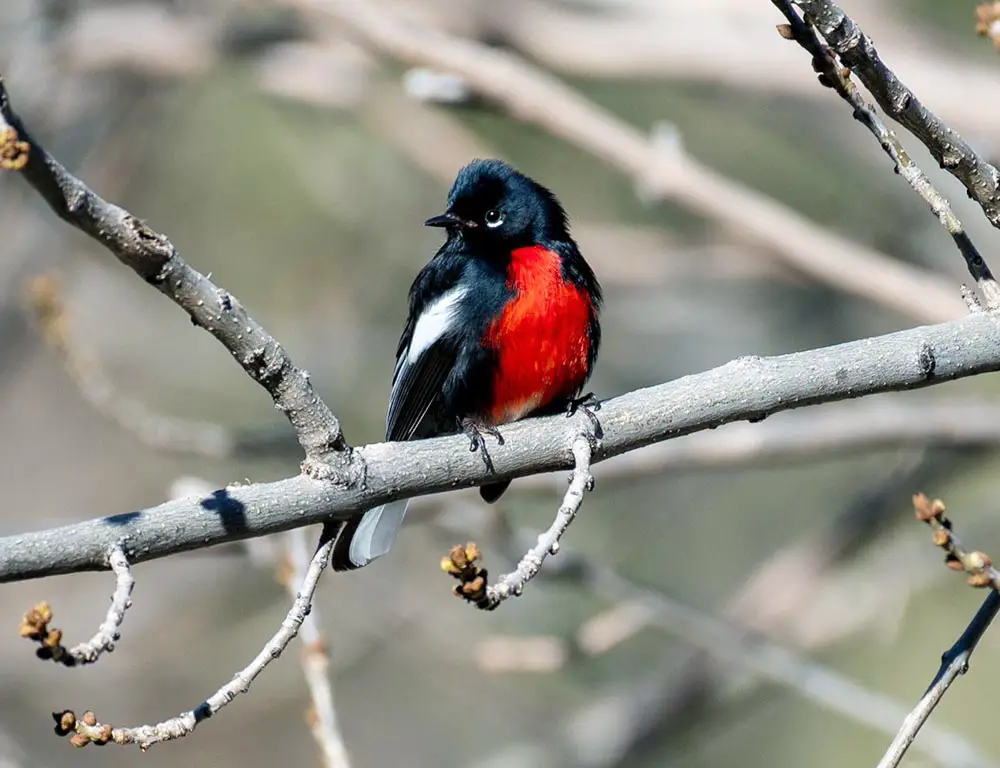
- Scientific Name: Myioborus pictus
- Size: 5.1–5.5 inches (13–14 cm)
- Weight: Approximately 0.4 ounces (11 g)
- Wingspan: 7.5–8.3 inches (19–21 cm)
- Population: Not precisely determined
- Life Span: 3 to 6 years
- Status: Least Concern (IUCN)
Found in southwestern North America, the Painted Redstart thrives in mountainous habitats. Sporting striking black, white, and red plumage, it’s an active, insectivorous bird.
Their foraging style includes hopping and fluttering, displaying remarkable agility. Breeding in coniferous forests, these birds construct cup-shaped nests on the ground.
Known for their energetic and conspicuous behaviors, Painted Redstarts contribute to the vibrant avian tapestry of their native ecosystems.
4. Rose-breasted Grosbeak
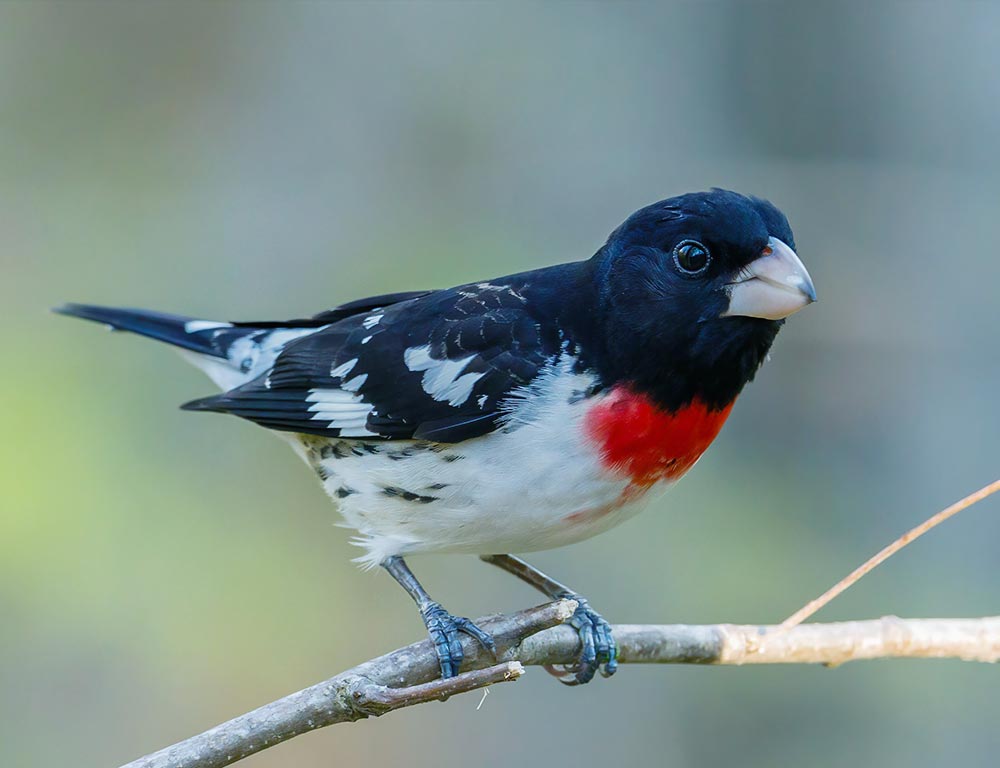
- Scientific Name: Pheucticus ludovicianus
- Size: 7.1–7.9 inches (18–20 cm)
- Weight: 1.1–1.6 ounces (31–45 g)
- Wingspan: 11–12.2 inches (28–31 cm)
- Population: Not precisely determined
- Life Span: 4 to 5 years
- Status: Least Concern (IUCN)
These medium-sized songbirds breed in North America, primarily in deciduous forests. Known for their distinctive black and white plumage with a rosy-red chest on males, Rose-breasted Grosbeaks feed on seeds, insects, and fruits.
During migration, they travel to wintering grounds in Central and South America. They are territorial and engage in melodious singing to establish and defend their nesting territories.
The Rose-breasted Grosbeak’s striking appearance and melodic tunes make it a delightful sight and sound in the diverse ecosystems it inhabits.
5. American Robin
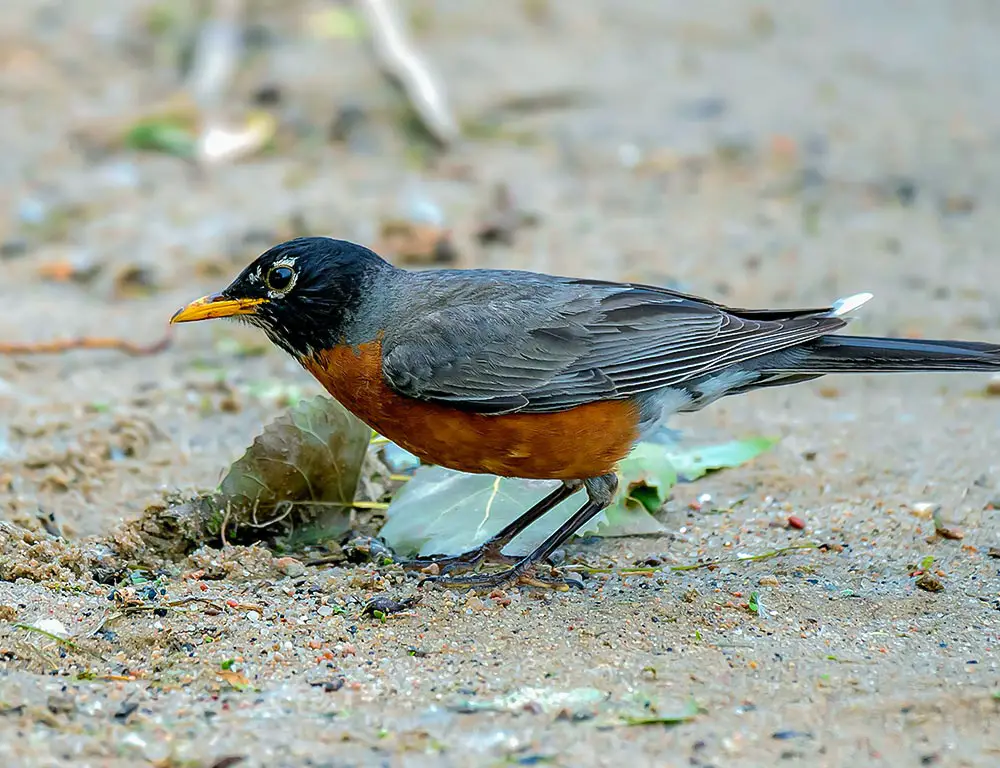
- Scientific Name: Turdus migratorius
- Size: 9–11 inches (23–28 cm)
- Weight: 2.7–3.0 ounces (77–85 g)
- Wingspan: 12–16 inches (31–41 cm)
- Population: Abundant and widespread
- Life Span: 2 years on average
- Status: Least Concern (IUCN)
A common sight across North America, the American Robin is a migratory bird known for its distinctive orange-red breast. It thrives in various habitats, including gardens and wooded areas.
Primarily insectivorous, it shifts to a fruit-based diet during winter. Robins are known for their cheerful songs and the characteristic hopping gait while foraging.
They often nest on trees and ledges, contributing to their adaptability to urban environments. Migrating in flocks, they cover long distances, showcasing a remarkable journey each year.
6. Scarlet Robin
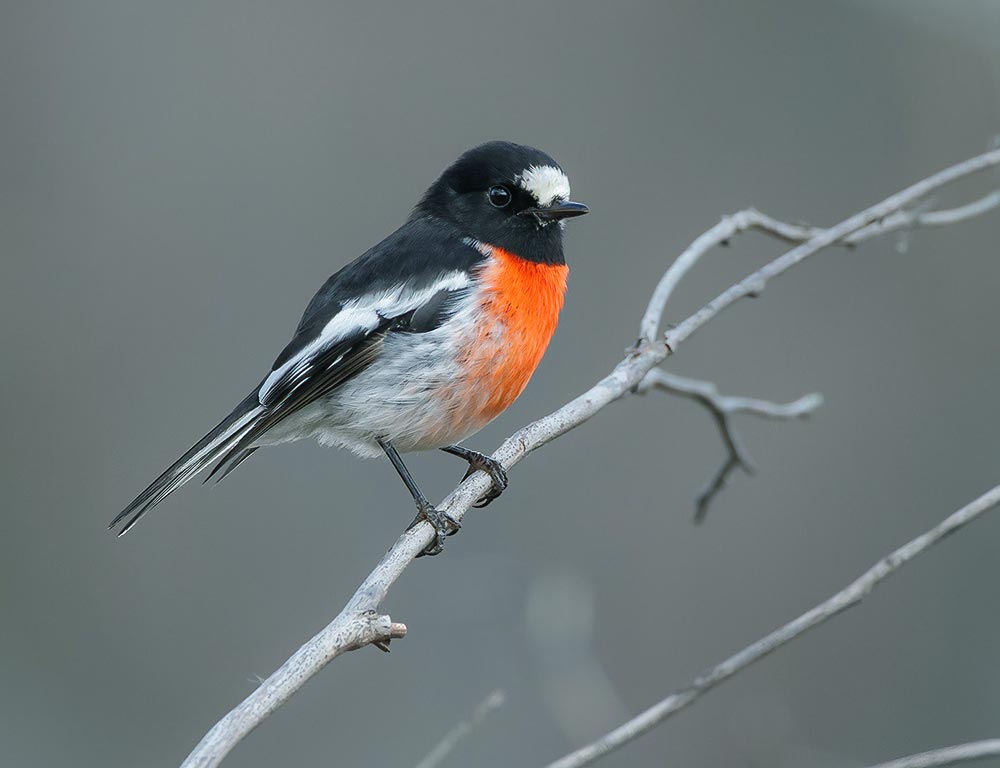
- Scientific Name: Petroica multicolor
- Size: 5.5–6.3 inches (14–16 cm)
- Weight: 0.4–0.7 ounces (12–20 g)
- Wingspan: 8.7 inches (22 cm)
- Population: Stable
- Life Span: 5–6 years
- Status: Least Concern (IUCN)
Endemic to Australia, the Scarlet Robin is a small, insectivorous bird with striking red and black plumage. Inhabiting eucalyptus forests and woodlands, it’s known for its territorial behavior.
Males display vibrant scarlet plumage, while females exhibit more subdued colors. Their melodious songs and agile hunting style contribute to their charm.
With a stable population, these robins are crucial to the Australian ecosystems, acting as both predators of insects and prey for larger birds.
7. Vermilion Flycatcher
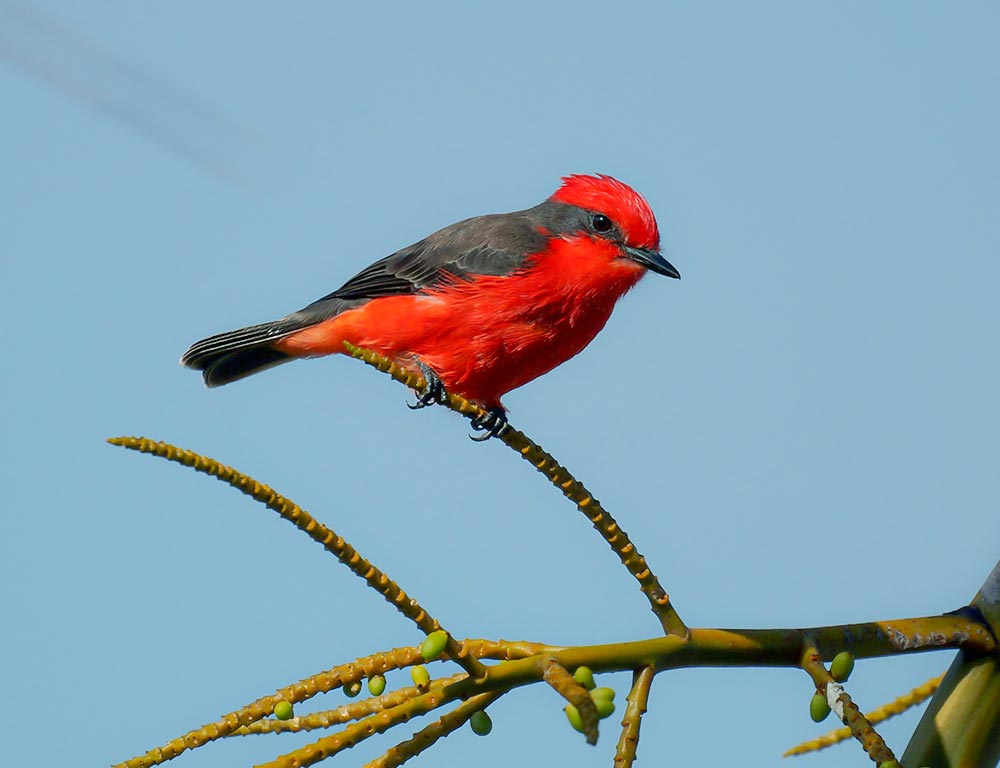
- Scientific Name: Pyrocephalus obscurus
- Size: 6.3–6.7 inches (16–17 cm)
- Weight: 0.6–0.7 ounces (17–20 g)
- Wingspan: 9.4–10.2 inches (24–26 cm)
- Population: Stable
- Life Span: 5–6 years
- Status: Least Concern (IUCN)
Residing in the Americas, from the southwestern U.S. to South America, the Vermilion Flycatcher is a visually striking bird. The male, with its vermilion plumage, engages in aerial displays to attract females.
Found in open habitats like grasslands and deserts, it primarily feeds on flying insects.
Known for its acrobatic flight and distinct calls, this flycatcher plays a role in controlling insect populations. Stable in numbers, these birds are adaptable to a variety of environments, contributing to the biodiversity of their habitats.
8. Red-breasted Sapsucker
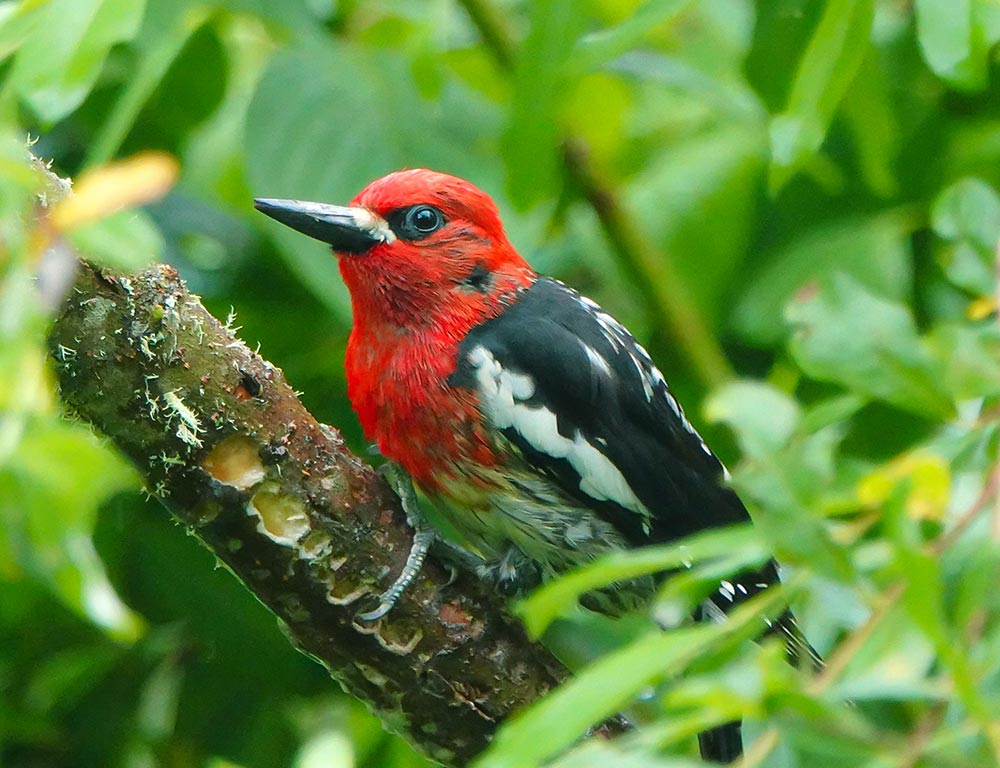
- Scientific Name: Sphyrapicus ruber
- Size: 7.5–8.7 inches (19–22 cm)
- Weight: 1.6–2.3 ounces (45–65 g)
- Wingspan: 13–15 inches (33–38 cm)
- Population: Stable
- Life Span: 4–7 years
- Status: Least Concern (IUCN)
Native to North America, the Red-breasted Sapsucker is a woodpecker species with a distinctive red head and breast.
As their name suggests, they feed on tree sap by drilling sapwells in the bark, attracting insects as well. Found in coniferous and mixed forests, they also consume insects, making them omnivorous.
Their drumming sounds and distinct calls contribute to the auditory richness of their habitats. With a stable population, these sapsuckers play a role in ecosystem dynamics by influencing the health of the trees they inhabit.
9. Pyrrhuloxia
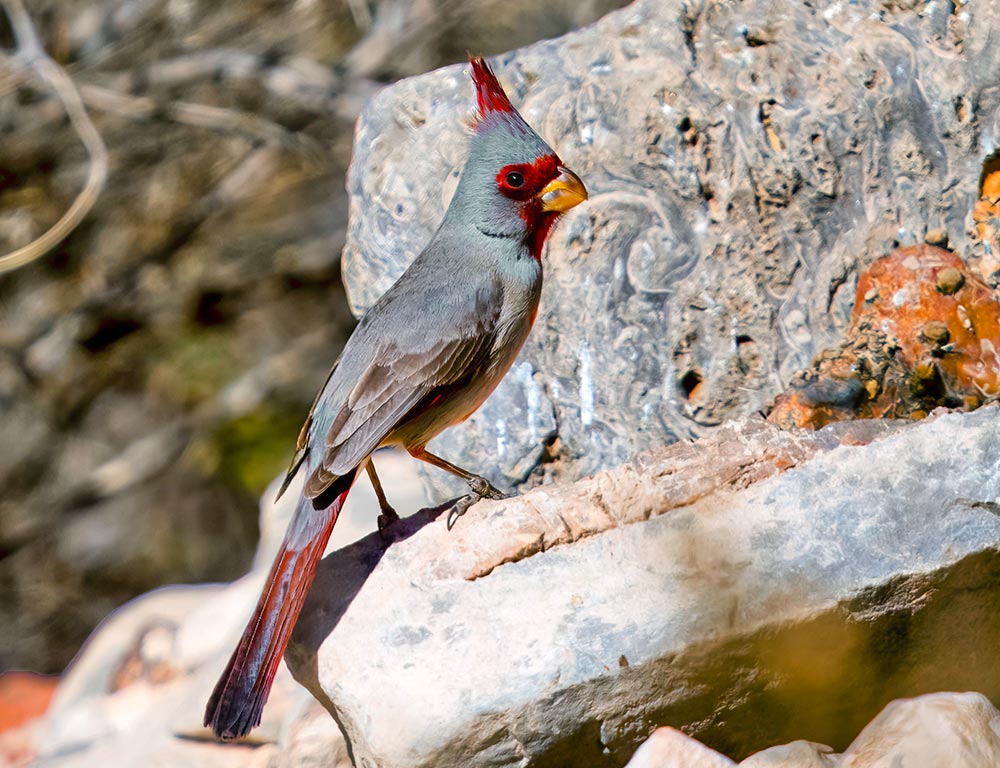
- Scientific Name: Cardinalis sinuatus
- Size: 7.5–9 inches (19–23 cm)
- Weight: 1.2–1.9 ounces (34–54 g)
- Wingspan: 11–12 inches (28–30 cm)
- Population: Stable
- Life Span: 3–4 years
- Status: Least Concern (IUCN)
Residing in arid regions of the southwestern United States and Mexico, the Pyrrhuloxia, or Desert Cardinal, is a bird adapted to desert habitats.
With a distinctive mix of red and gray plumage, they feed on seeds, fruits, and insects. Known for their melodious calls, these birds often inhabit thorny shrubs and cacti.
They are monogamous and form pairs during the breeding season. Despite their preference for arid landscapes, Pyrrhuloxias exhibit adaptability and resilience in the face of environmental challenges.
10. House Finch

- Scientific Name: Haemorhous mexicanus
- Size: 5–6 inches (13–15 cm)
- Weight: 0.7–1.1 ounces (20–31 g)
- Wingspan: 8–10 inches (20–25 cm)
- Population: Abundant and widespread
- Life Span: 2–7 years
- Status: Least Concern (IUCN)
Adaptable and widespread, the House Finch is native to western North America but has successfully expanded its range across the continent.
Recognizable by the males’ red plumage, they are granivores, feeding on seeds, grains, and berries. Commonly found in urban and suburban areas, House Finches display communal roosting behavior.
Their melodious songs and vibrant colors make them a popular sight in various environments. They form loose colonies and are known for their resilience and ability to thrive in diverse habitats.
11. Purple Finch
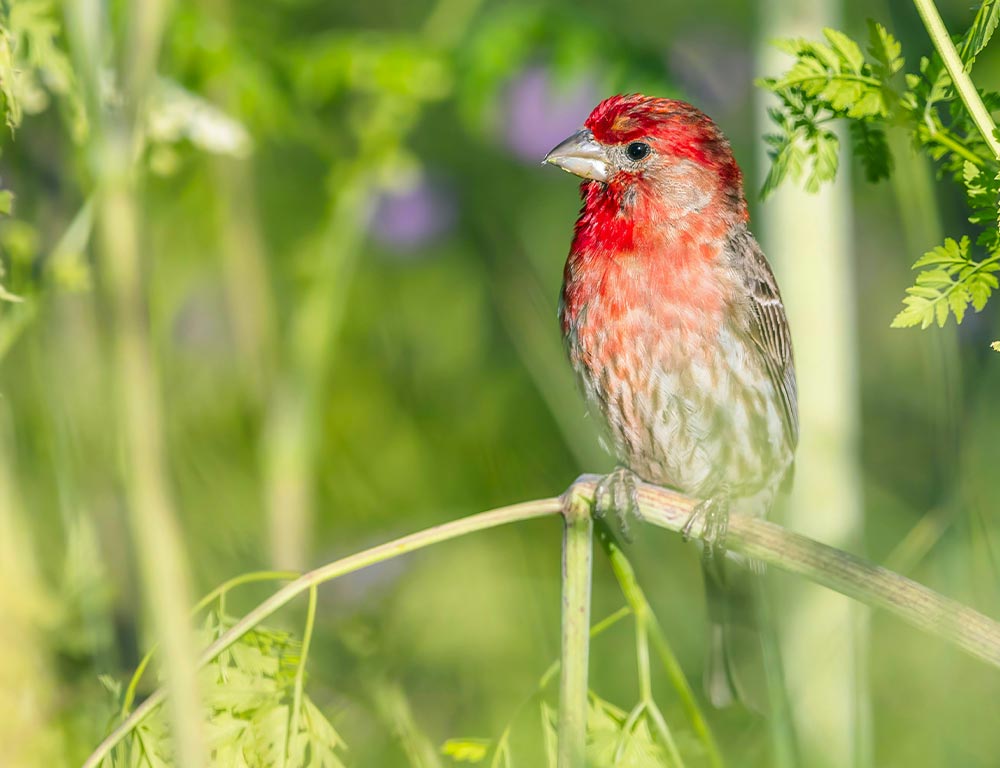
- Scientific Name: Haemorhous purpureus
- Size: 6–7 inches (15–18 cm)
- Weight: 0.8–1.2 ounces (23–34 g)
- Wingspan: 10–11 inches (25–28 cm)
- Population: Stable
- Life Span: 3–5 years
- Status: Least Concern (IUCN)
Native to North America, the Purple Finch is known for the males’ vibrant purple-red plumage. Inhabiting coniferous and mixed forests, they primarily feed on seeds, buds, and berries.
During the breeding season, males sing intricate songs to attract mates. Purple Finches are both migratory and sedentary, with some populations remaining year-round in their habitats.
With a stable population, these finches contribute to the biodiversity of their ecosystems through their foraging habits and important role as seed dispersers.
12. Summer Tanager
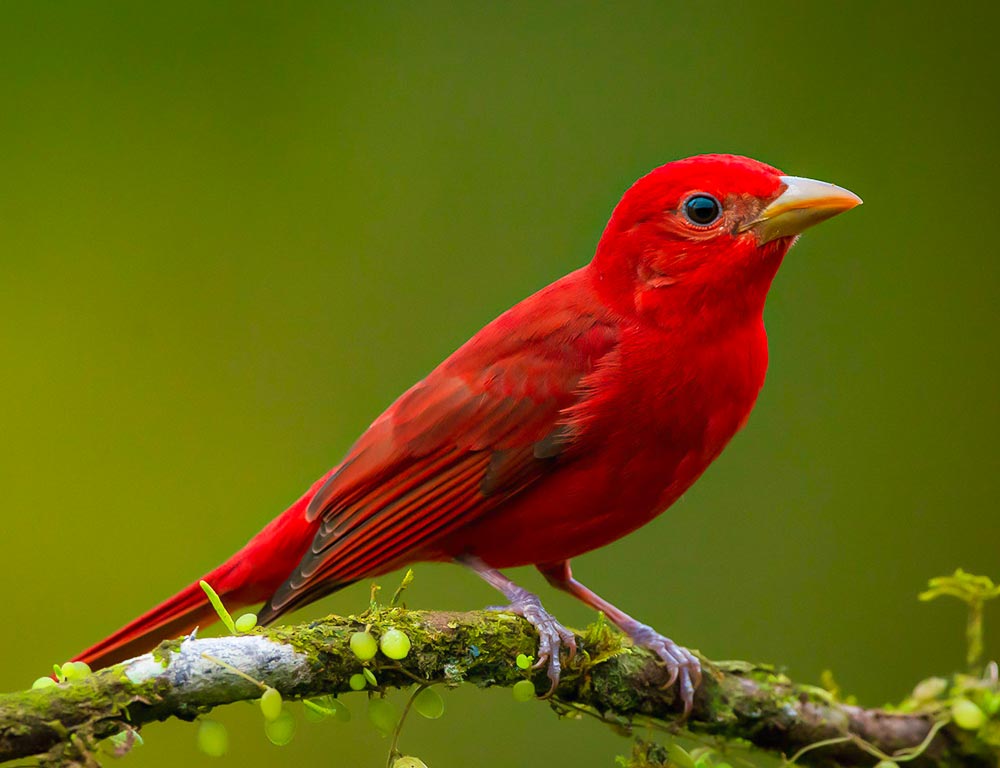
- Scientific Name: Piranga rubra
- Size: 6.7–7.9 inches (17–20 cm)
- Weight: 1.0–1.3 ounces (29–37 g)
- Wingspan: 11–12 inches (28–30 cm)
- Population: Stable
- Life Span: 2–5 years
- Status: Least Concern (IUCN)
Found in the Americas, the Summer Tanager is a bird known for its predominantly red plumage. They inhabit various forested habitats and are skilled aerial foragers, catching insects mid-air.
Migrating between North and South America, they spend their summers breeding in North America. Male Summer Tanagers are brilliant red, while females display a more subdued yellowish color.
With a stable population, these tanagers contribute to pest control through their insect-eating habits and add vibrant colors to the diverse avian community in their habitats.
13. Hepatic Tanager
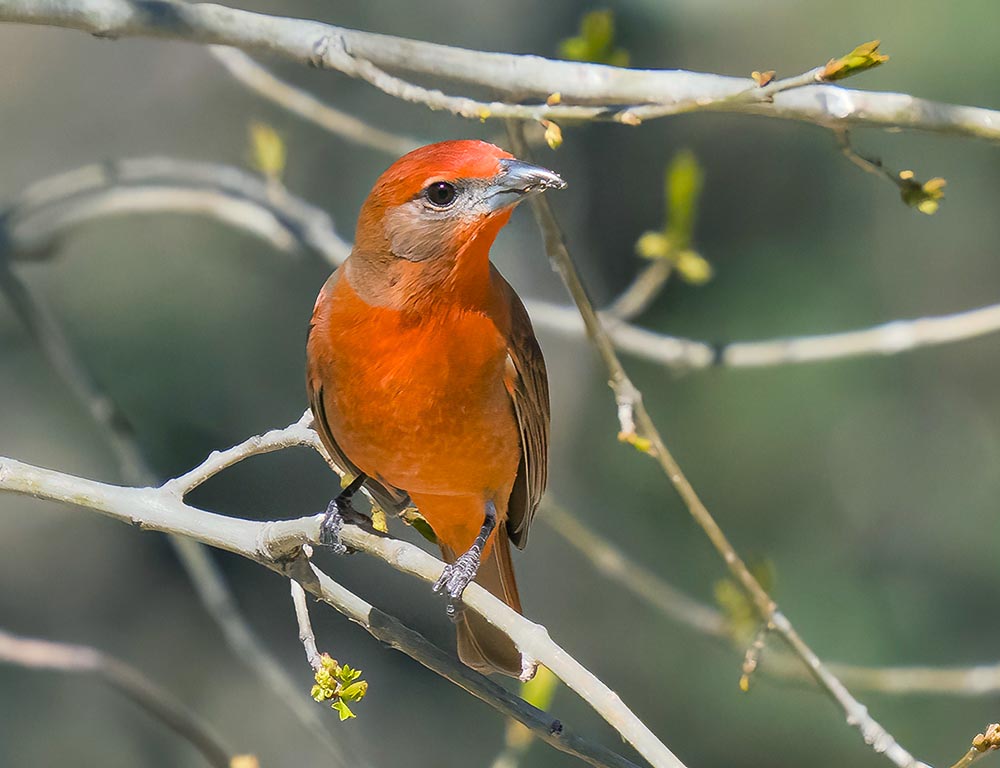
- Scientific Name: Piranga flava
- Size: 7.5–8 inches (19–20 cm)
- Weight: Approximately 1.2 ounces (34 g)
- Wingspan: 11 inches (28 cm)
- Population: Not precisely determined
- Life Span: 3–4 years
- Status: Least Concern (IUCN)
Native to western North America, the Hepatic Tanager is often found in mountainous and forested habitats.
Named for its liver-colored plumage, it primarily feeds on insects, spiders, and berries. These tanagers are known for their solitary behavior, often perching in the canopy or mid-story of trees.
During the breeding season, males sing melodious songs to establish territories and attract mates. While not extensively studied, their contribution to seed dispersal and insect control makes them integral to the ecosystems they inhabit.
14. Elegant Trogon
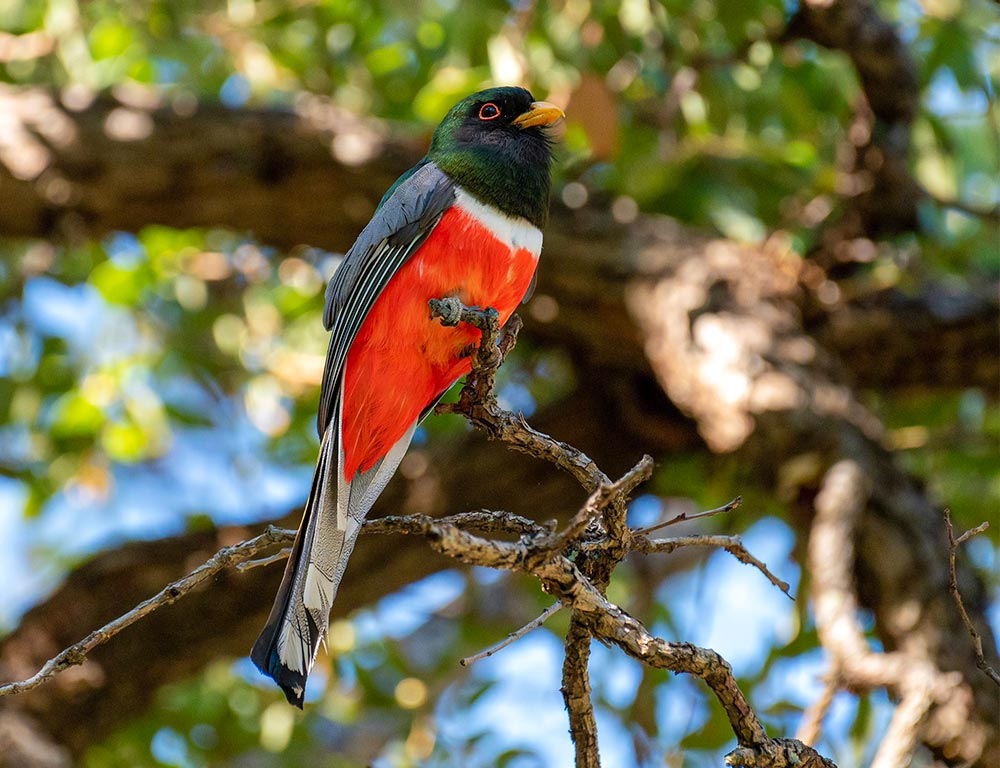
- Scientific Name: Trogon elegans
- Size: 10–12 inches (25–30 cm)
- Weight: 4–5 ounces (113–142 g)
- Wingspan: Approximately 13 inches (33 cm)
- Population: Not precisely determined
- Life Span: 5–8 years
- Status: Least Concern (IUCN)
Residing in tropical and subtropical forests from the southwestern United States to Central America, the Elegant Trogon is a strikingly colorful bird.
Males boast iridescent green and red plumage, while females exhibit more subdued brown and white tones. Their diet consists mainly of insects and fruit. Nesting in tree cavities, these trogons are known for their elusive behavior.
Their populations face threats from habitat loss, making conservation efforts crucial to preserving their unique beauty within these diverse ecosystems.
15. Grey Crowned Crane
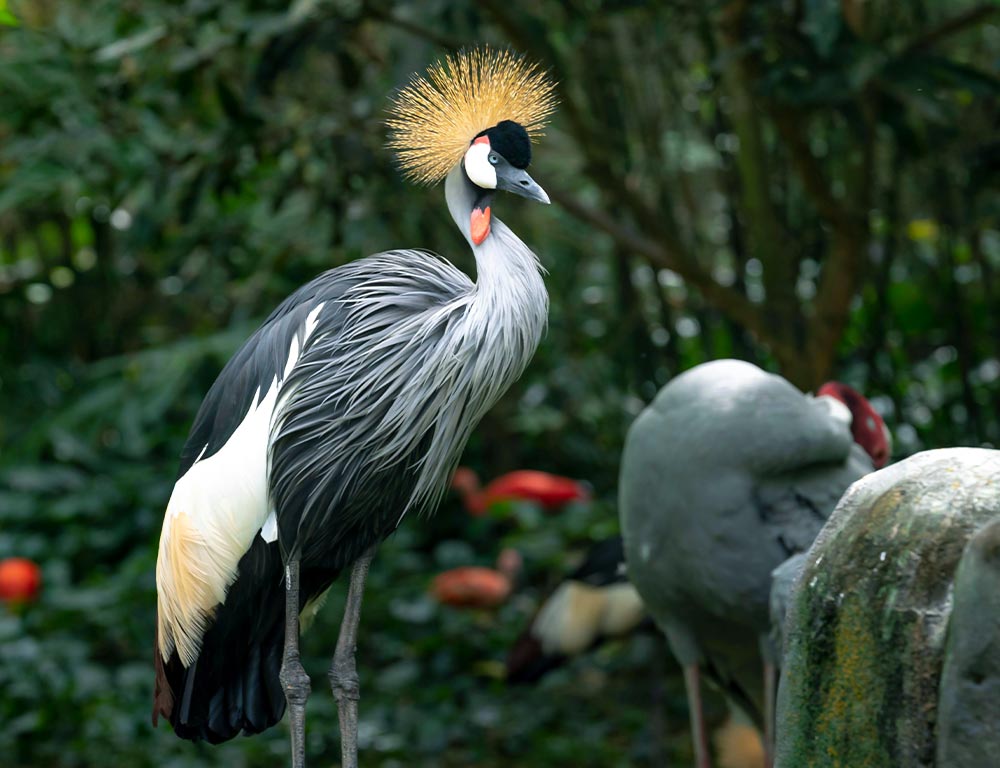
- Scientific Name: Balearica regulorum
- Size: 3.3–3.6 feet (1–1.1 meters) tall
- Weight: 7.7–10.4 pounds (3.5–4.7 kg)
- Wingspan: 6.6–7.5 feet (2–2.3 meters)
- Population: Decreasing
- Life Span: 22 years (in captivity)
- Status: Endangered (IUCN)
Native to Africa, the Grey Crowned Crane is known for its distinctive crown of golden feathers. Inhabiting wetlands and grasslands, they feed on seeds, insects, and small vertebrates.
With elaborate courtship dances involving wing-flapping and leaps, they form monogamous pairs during the breeding season.
Unfortunately, their populations are declining due to habitat loss and human activities. Conservation efforts are critical to ensuring the survival of this charismatic species, which is also a symbol of African culture and biodiversity.
16. Southern Grey Crowned Crane

- Scientific Name: Balearica regulorum gibbericeps
- Size: 3.3–3.6 feet (1–1.1 meters) tall
- Weight: 8.8–10.4 pounds (4–4.7 kg)
- Wingspan: 6.6–7.5 feet (2–2.3 meters)
- Population: Decreasing
- Life Span: 22 years (in captivity)
- Status: Endangered (IUCN)
Similar to its northern counterpart, the Southern Grey Crowned Crane is native to Africa. Recognized by its golden crown of feathers, it inhabits wetlands and grasslands.
Their diet includes seeds, insects, and small vertebrates. Displaying elaborate courtship dances, they form monogamous pairs during the breeding season.
Unfortunately, this crane is facing a decline in population due to habitat loss and human activities. Conservation efforts are essential to protect this endangered species and preserve the ecological balance of its habitats.
17. Black-necked Grebe
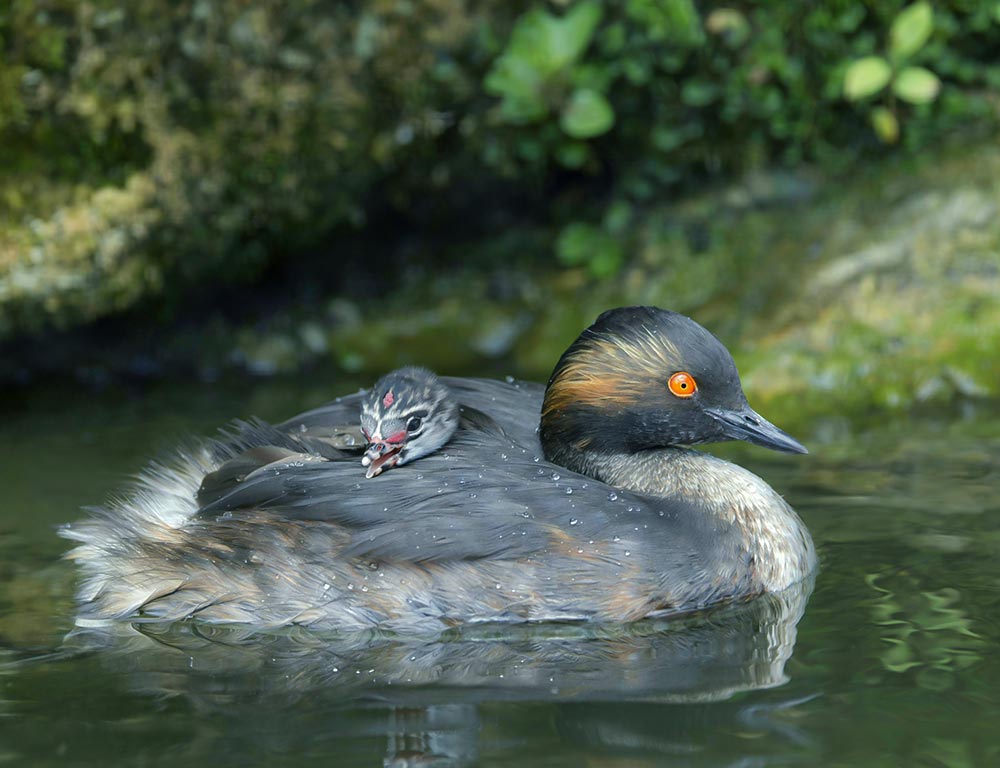
- Scientific Name: Podiceps nigricollis
- Size: 11–13 inches (28–33 cm)
- Weight: 7.5–13.4 ounces (212–380 g)
- Wingspan: 18–20 inches (46–51 cm)
- Population: Not precisely determined
- Life Span: 4–8 years
- Status: Least Concern (IUCN)
The Black-necked Grebe is a waterbird found across Europe and Asia, inhabiting freshwater lakes and ponds. During the breeding season, they develop striking black plumage on their necks and heads.
These grebes are skilled divers, preying on fish and invertebrates. Their nesting colonies are often located on floating vegetation.
In winter, their plumage becomes more subdued. Though they face threats from habitat degradation, they are currently classified as Least Concern, but continued monitoring is essential for their conservation.
18. White-necked Laughingthrush
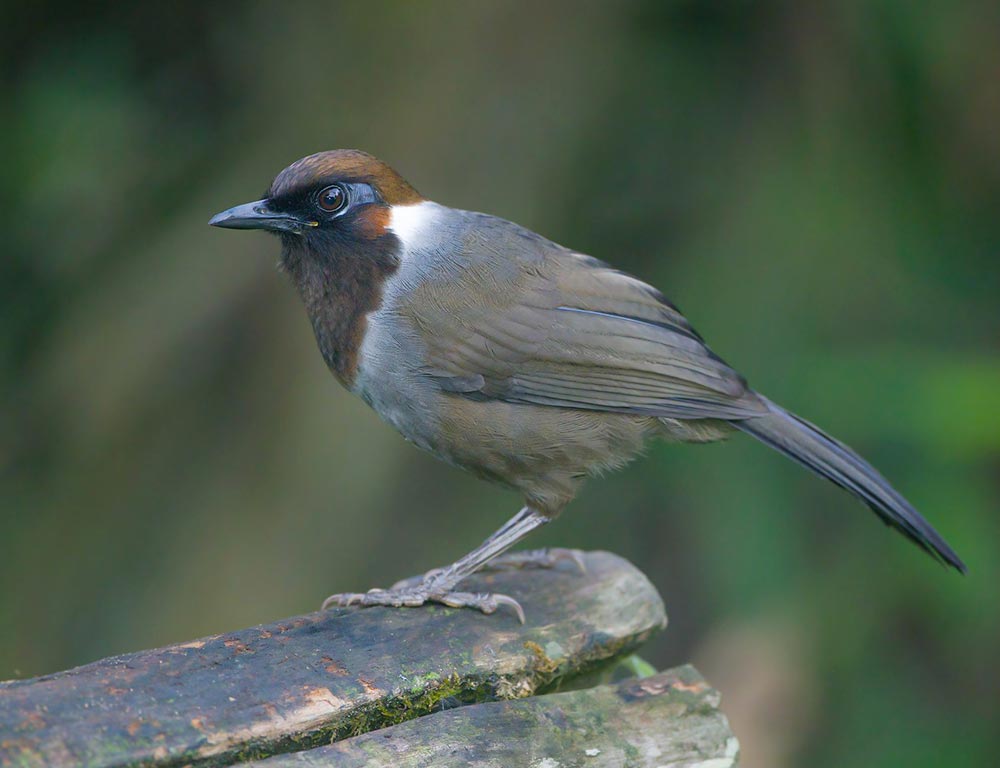
- Scientific Name: Garrulax strepitans
- Size: 9–11 inches (23–28 cm)
- Weight: Approximately 2 ounces (56 g)
- Wingspan: Not precisely determined
- Population: Not precisely determined
- Life Span: Not well-documented
- Status: Least Concern (IUCN)
Endemic to the eastern Himalayas, the White-necked Laughingthrush is characterized by its distinctive white throat and chest.
These social birds inhabit dense forests and are often found in flocks, engaging in communal activities such as foraging and bathing. Their melodious calls and laughter-like sounds contribute to the lively atmosphere of their habitats.
Although their population is not precisely determined, they are currently listed as Least Concern, but habitat loss remains a potential threat to their future well-being.
19. White-crested Laughingthrush
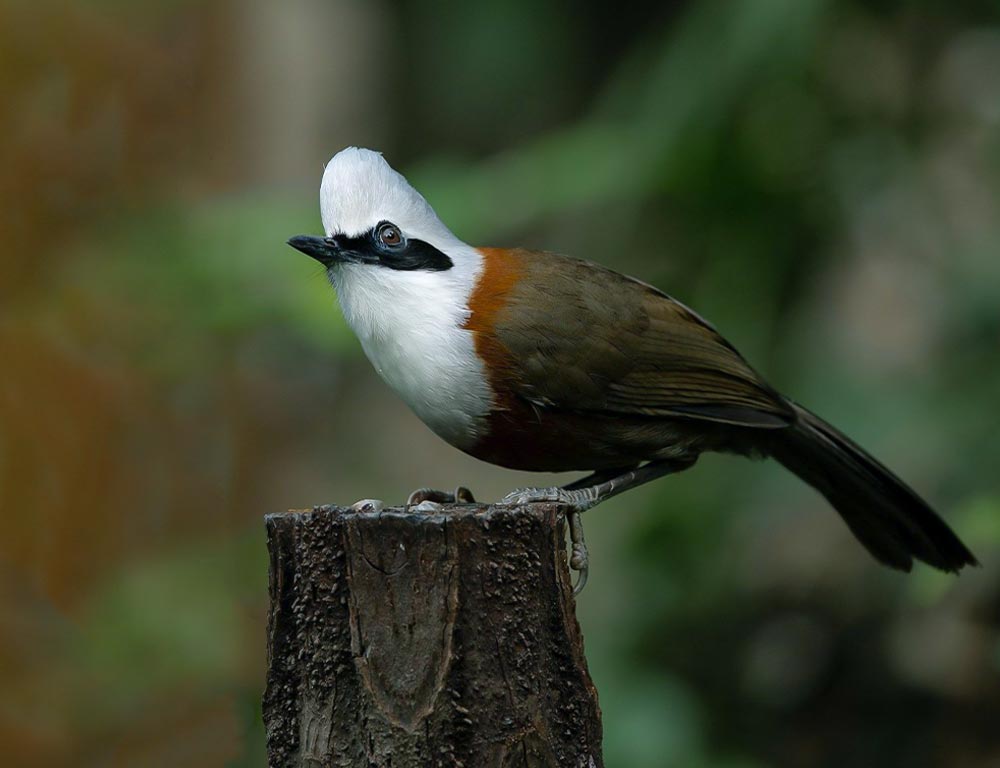
- Scientific Name: Garrulax leucolophus
- Size: 9–11 inches (23–28 cm)
- Weight: Approximately 2 ounces (56 g)
- Wingspan: Not precisely determined
- Population: Not precisely determined
- Life Span: Not well-documented
- Status: Least Concern (IUCN)
The White-crested Laughingthrush, scientifically known as Garrulax leucolophus, is native to the Indian subcontinent and Southeast Asia.
Recognizable by its white crest and chestnut-colored body, these birds inhabit dense forests. Similar to other laughingthrush species, they are social and vocal, engaging in cooperative behaviors within their flocks.
Though their population status is not precisely determined, they are currently classified as Least Concern. Conservation efforts should focus on protecting their habitats from deforestation and other threats.
20. Mangrove Grey Crowned Crane
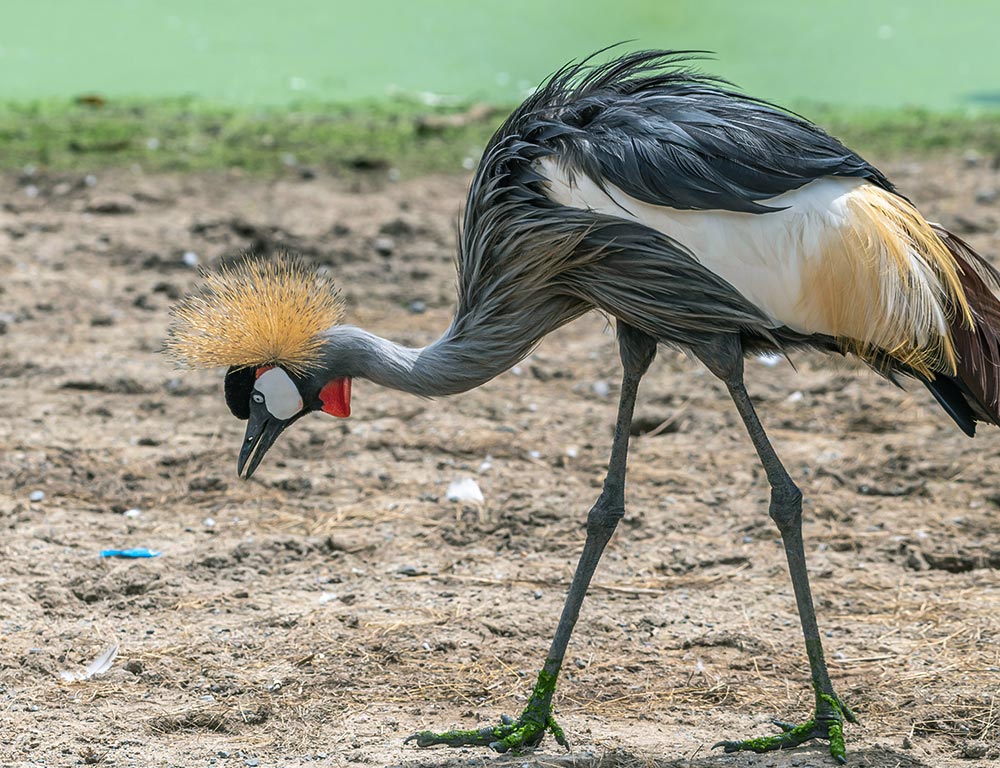
- Scientific Name: Balearica regulorum gibbericeps
- Size: 3.3–3.6 feet (1–1.1 meters) tall
- Weight: 8.8–10.4 pounds (4–4.7 kg)
- Wingspan: 6.6–7.5 feet (2–2.3 meters)
- Population: Decreasing
- Life Span: 22 years (in captivity)
- Status: Endangered (IUCN)
The Mangrove Grey Crowned Crane, a subspecies of the Grey Crowned Crane, is native to coastal regions of East Africa, including mangrove ecosystems. Like its counterpart, it displays a distinctive crown of golden feathers.
Inhabiting wetlands and mangrove areas, these cranes feed on seeds, insects, and small vertebrates. They are known for their elaborate courtship dances, forming monogamous pairs during the breeding season.
Unfortunately, their populations are decreasing due to habitat loss and human activities. Conservation efforts are vital to protect this endangered species and preserve the delicate balance of mangrove ecosystems.
Wrapping Up
The diverse array of birds with red chests, such as the Scarlet Tanager, Northern Cardinal, Painted Redstart, and Rose-breasted Grosbeak, reflects the beauty and adaptability within avian ecosystems.
These birds play integral roles in their respective habitats, contributing to biodiversity and ecosystem balance.
From the Scarlet Tanager’s vibrant plumage in North America to the Northern Cardinal’s resilience in urban settings, each species showcases unique behaviors and characteristics.
The Painted Redstart’s agility in southwestern landscapes and the Rose-breasted Grosbeak’s melodious tunes further emphasize the significance of these birds in the intricate tapestry of nature.
Studying and appreciating these feathered wonders not only deepens our understanding of ecological dynamics but also underscores the need for conservation efforts to ensure the continued thriving of these splendid species.